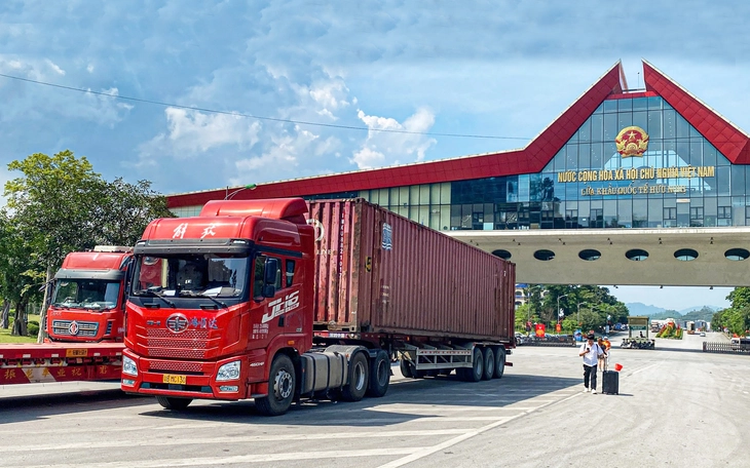
Chinese goods are cleared at Huu Nghi International Border Gate in Lang Son Province, northern Vietnam. Photo: Ha Quan
The visit also serves as a reminder that China was the first country to establish diplomatic relations with the Democratic Republic of Vietnam on January 18, 1950 – exactly 75 years ago.
Over the past three-quarters of a century, Vietnam and China have shared historic moments and witnessed regional and global transformations together.
Vietnam and China extend highest diplomatic honors
During Xi's third state visit to Vietnam in December 2023, the two nations agreed to elevate their relationship by signing an agreement to build a 'Vietnam-China Community with a Shared Future of Strategic Significance.'
This landmark agreement is guided by six key principles proposed by Xi, often referred to as the 'six mores': higher political trust, more substantive defense and security cooperation, deeper practical collaboration, a stronger social foundation, closer multilateral coordination, and better management and resolution of differences.
In recent years, the relationship between Vietnam and China has gone beyond the usual friendly neighborly diplomacy, with both sides extending the highest levels of respect to one another.
In 2022, Vietnamese General Secretary Nguyen Phu Trong was the first foreign leader to be received by Xi after the 20th National Congress of the Communist Party of China.
Xi has also become the Chinese leader with the most visits to Vietnam in the history of the People's Republic of China, having visited in November 2015, November 2017, December 2023, and now in April 2025.
Since the COVID-19 pandemic, top-level visits between the two countries have occurred regularly.
In August last year, just two weeks after assuming office, Vietnamese General Secretary To Lam visited China to strengthen political trust and advance the building of the shared future community.

Border guards assist drivers with customs procedures at Huu Nghi International Border Gate in Lang Son Province, northern Vietnam. Photo: Ha Quan
A bright spot in economic and trade cooperation
Economic and trade cooperation stands out as the brightest aspect of the Vietnam-China relationship.
China has been Vietnam's largest trading partner for more than two decades, beginning in 2004.
Meanwhile, Vietnam is China's largest trading partner within ASEAN and ranks fourth among China's national trading partners.
According to China's Ministry of Commerce, bilateral trade between the two countries reached US$260.65 billion in 2024, a 13.5-percent increase from the previous year.
Trade between Vietnam and China now accounts for 25 percent of Vietnam's total global import-export volume.
This growing interdependence plays a vital role in maintaining balance during a time of global trade uncertainty.
The rise in trade has yielded widespread benefits.
Vietnamese farmers, in particular, have increasingly tapped into China's market of 1.4 billion consumers. China is the primary export destination for Vietnam's agricultural, forestry, and seafood products, including rubber, fruits (such as durian, fresh coconut, and dragon fruit), cassava, and aquatic products.
Notably, Vietnam's durian exports to China exceeded $3 billion last year, following a surprising $2.3 billion in 2023.
In recent years, the Chinese government has expanded the list of Vietnamese agricultural imports – from bananas and rubber to durians, jackfruits, and mangoes – offering Vietnamese farmers greater access to a vast market with an average per capita income exceeding $13,000 per year.
Chinese investment in Vietnam has also surged, making China the country's third-largest foreign investor in 2024, behind only Singapore and South Korea.
According to consulting firm Dezan Shira & Associates, Vietnam's geographic proximity to China has positioned it as a rising global manufacturing hub.
The long shared land border between the two nations facilitates seamless supply chain integration, especially as multinational companies diversify their manufacturing bases.
Upcoming rail projects connecting key manufacturing and trade centers between Vietnam and China are expected to take bilateral trade and investment to new heights.



Max: 1500 characters
There are no comments yet. Be the first to comment.